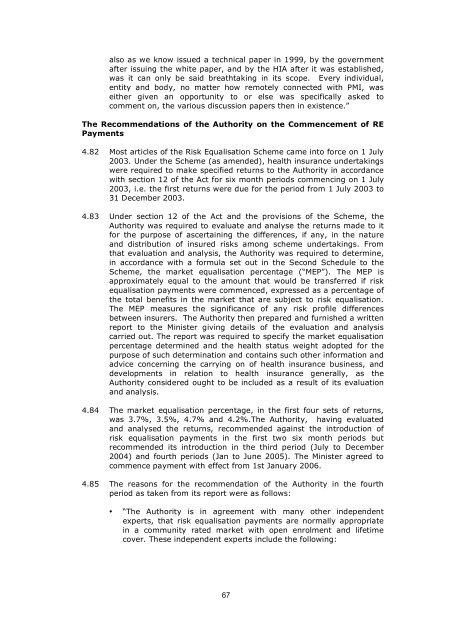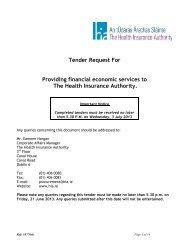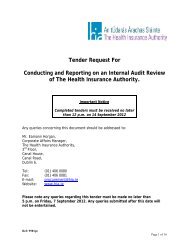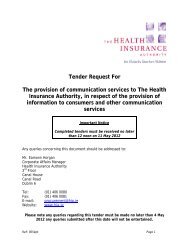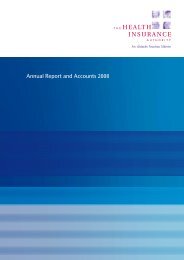Competition in the Irish Private Health Insurance Market
Competition in the Irish Private Health Insurance Market
Competition in the Irish Private Health Insurance Market
Create successful ePaper yourself
Turn your PDF publications into a flip-book with our unique Google optimized e-Paper software.
also as we know issued a technical paper <strong>in</strong> 1999, by <strong>the</strong> government<br />
after issu<strong>in</strong>g <strong>the</strong> white paper, and by <strong>the</strong> HIA after it was established,<br />
was it can only be said breathtak<strong>in</strong>g <strong>in</strong> its scope. Every <strong>in</strong>dividual,<br />
entity and body, no matter how remotely connected with PMI, was<br />
ei<strong>the</strong>r given an opportunity to or else was specifically asked to<br />
comment on, <strong>the</strong> various discussion papers <strong>the</strong>n <strong>in</strong> existence.”<br />
The Recommendations of <strong>the</strong> Authority on <strong>the</strong> Commencement of RE<br />
Payments<br />
4.82 Most articles of <strong>the</strong> Risk Equalisation Scheme came <strong>in</strong>to force on 1 July<br />
2003. Under <strong>the</strong> Scheme (as amended), health <strong>in</strong>surance undertak<strong>in</strong>gs<br />
were required to make specified returns to <strong>the</strong> Authority <strong>in</strong> accordance<br />
with section 12 of <strong>the</strong> Act for six month periods commenc<strong>in</strong>g on 1 July<br />
2003, i.e. <strong>the</strong> first returns were due for <strong>the</strong> period from 1 July 2003 to<br />
31 December 2003.<br />
4.83 Under section 12 of <strong>the</strong> Act and <strong>the</strong> provisions of <strong>the</strong> Scheme, <strong>the</strong><br />
Authority was required to evaluate and analyse <strong>the</strong> returns made to it<br />
for <strong>the</strong> purpose of ascerta<strong>in</strong><strong>in</strong>g <strong>the</strong> differences, if any, <strong>in</strong> <strong>the</strong> nature<br />
and distribution of <strong>in</strong>sured risks among scheme undertak<strong>in</strong>gs. From<br />
that evaluation and analysis, <strong>the</strong> Authority was required to determ<strong>in</strong>e,<br />
<strong>in</strong> accordance with a formula set out <strong>in</strong> <strong>the</strong> Second Schedule to <strong>the</strong><br />
Scheme, <strong>the</strong> market equalisation percentage (“MEP”). The MEP is<br />
approximately equal to <strong>the</strong> amount that would be transferred if risk<br />
equalisation payments were commenced, expressed as a percentage of<br />
<strong>the</strong> total benefits <strong>in</strong> <strong>the</strong> market that are subject to risk equalisation.<br />
The MEP measures <strong>the</strong> significance of any risk profile differences<br />
between <strong>in</strong>surers. The Authority <strong>the</strong>n prepared and furnished a written<br />
report to <strong>the</strong> M<strong>in</strong>ister giv<strong>in</strong>g details of <strong>the</strong> evaluation and analysis<br />
carried out. The report was required to specify <strong>the</strong> market equalisation<br />
percentage determ<strong>in</strong>ed and <strong>the</strong> health status weight adopted for <strong>the</strong><br />
purpose of such determ<strong>in</strong>ation and conta<strong>in</strong>s such o<strong>the</strong>r <strong>in</strong>formation and<br />
advice concern<strong>in</strong>g <strong>the</strong> carry<strong>in</strong>g on of health <strong>in</strong>surance bus<strong>in</strong>ess, and<br />
developments <strong>in</strong> relation to health <strong>in</strong>surance generally, as <strong>the</strong><br />
Authority considered ought to be <strong>in</strong>cluded as a result of its evaluation<br />
and analysis.<br />
4.84 The market equalisation percentage, <strong>in</strong> <strong>the</strong> first four sets of returns,<br />
was 3.7%, 3.5%, 4.7% and 4.2%.The Authority, hav<strong>in</strong>g evaluated<br />
and analysed <strong>the</strong> returns, recommended aga<strong>in</strong>st <strong>the</strong> <strong>in</strong>troduction of<br />
risk equalisation payments <strong>in</strong> <strong>the</strong> first two six month periods but<br />
recommended its <strong>in</strong>troduction <strong>in</strong> <strong>the</strong> third period (July to December<br />
2004) and fourth periods (Jan to June 2005). The M<strong>in</strong>ister agreed to<br />
commence payment with effect from 1st January 2006.<br />
4.85 The reasons for <strong>the</strong> recommendation of <strong>the</strong> Authority <strong>in</strong> <strong>the</strong> fourth<br />
period as taken from its report were as follows:<br />
• “The Authority is <strong>in</strong> agreement with many o<strong>the</strong>r <strong>in</strong>dependent<br />
experts, that risk equalisation payments are normally appropriate<br />
<strong>in</strong> a community rated market with open enrolment and lifetime<br />
cover. These <strong>in</strong>dependent experts <strong>in</strong>clude <strong>the</strong> follow<strong>in</strong>g:<br />
67


